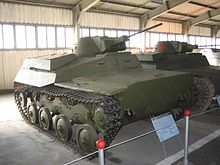Water propulsion was achieved via a small propeller mounted at the rear of the hull. The propeller was set into an indent in the hull rear, and was thus better protected than the exposed propeller of the T-38. Buoyancy was provided by the large boat-shaped hull.
The T-40 entered production just prior to the outbreak of war, and was intended to equip reconnaissance units. As the need for large numbers of tanks became critical, a secondary non-amphibious variant was designed on the T-40 chassis. This design became the T-60. The T-60 was simpler, cheaper, better armed, and could fulfill most of the same roles. Under the stress of war, production of the T-40 was halted in favor of the T-60. Thus only 222 T-40s were issued, compared to over 6,000 T-60s.
The last batch of T-40s were produced with BM-8-24 Katyusha rocket racks mounted instead of a turret. This version provided a mobile mount for a 24-rail multiple-launch rocket system, firing 82 mm unguided rockets.
A total of 44 T-40s were converted into this model in autumn 1941.
There was also the T30A and the T30B light tanks, which were the prototypes of the T-40 and T-60 respectively. Both of them were armed with a 20 mm cannon with a DT machine gun. These prototypes were preserved in the Kubinka Tank Museum.
The T-40 was widely photographed at the time of Operation Barbarossa and also during the defence of Moscow. Many were knocked out during the fighting. The type was very rarely seen after the end of 1941, although some T-40s remained in service as late 1946 in some school units.
| T-40 amphibious scout tank | |
|---|---|

A T-40 in the Kubinka Tank Museum.
| |
| Type | Amphibious light tank |
| Place of origin | Soviet Union |
| Service history | |
| In service | 1941–46 |
| Used by | Soviet Union |
| Wars | World War II |
| Production history | |
| Produced | 1940–41 |
| Number built | 222 |
| Variants | BM-8-24 Katyusha, T-30 light tank |
| Specifications ([1][2][3]) | |
| Weight | 5.9 t (6.5 short tons) |
| Length | 4.10 m (13.5 ft) |
| Width | 2.33 m (7.6 ft) |
| Height | 1.90 m (6.2 ft) |
| Crew | 2 |
| Armour | 4–13 mm (0.16–0.51 in) |
Main
armament | 12.7 mm (0.50 in) DShK machine gun |
Secondary
armament | 7.62 mm (0.300 in) DT machine gun |
| Engine | GAZ-202 85 hp (63 kW) |
| Power/weight | 12 hp/tonne |
| Suspension | torsion bar |
Operational
range | 450 km (280 mi) |
| Speed | 45 km/h (28 mph) |






Ei kommentteja:
Lähetä kommentti
Any explosive ammunition or empty cores, you can put in this.